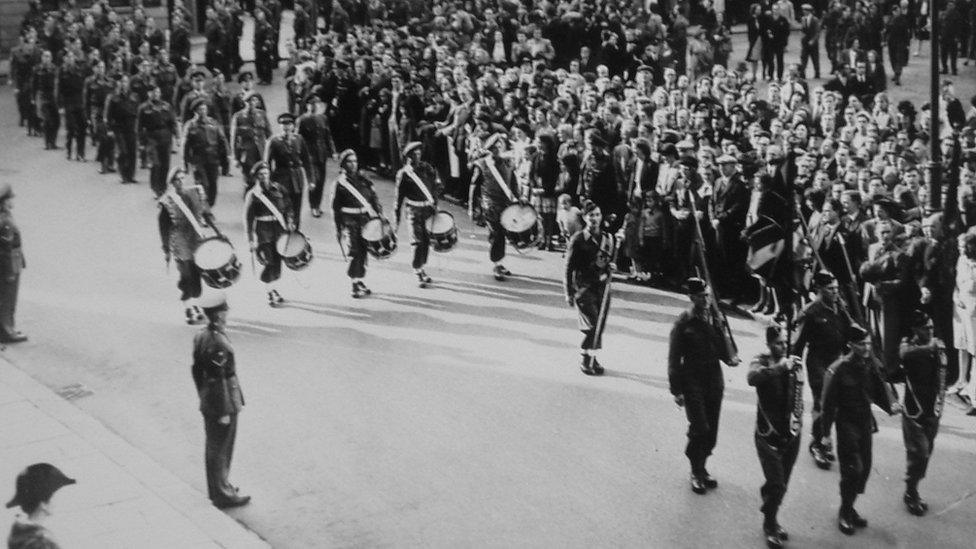VJ Day: WW2 soldier's son surprise at hidden drums story
- Published

Ernest "Ernie" Morgan, pictured in 1939, volunteered with the territorial Cambridgeshire Regiment from the mid-1920s
The son of a World War Two soldier has spoken of his surprise at learning how his father hid his regiment's drums during the 1942 fall of Singapore.
Ernest Morgan rarely talked about his wartime experiences, which included years of starvation and forced labour as a Japanese prisoner of war (PoW).
The Cambridgeshire Regiment drums he hid were rediscovered by chance in 1946 and repatriated for a reunion parade.
Paul Morgan said the story came as a "complete surprise" to him.

The drums were repatriated to Britain in 1946 and paraded through Cambridge - silent to mark the regiment's losses
Quartermaster Sgt Morgan, 32, arrived in Singapore with the Second Battalion on 29 January 1942 during heavy fighting with the Japanese.
The former Cambridge shop worker was tasked with hiding the regiment's 22 drums and other kit, alongside Sgt Ron Kitson and about 20 soldiers.
They were rapidly called away to join the resistance to the Japanese invasion at Adam Park, external.

Two of the drums, which date back to about 1910, are kept at Ely Museum and the other three at the Imperial War Museum in Duxford
Historian Felix Jackson, co-founder of the Cambridgeshire Regiment Research Trust, external, said: "A myth has grown up that the Cambridgeshires stepped off the boat and were captured.
"Many people are unaware how fiercely they fought against battle-hardened soldiers to defend the island before it fell on 15 February."
Sgt Morgan was captured at Adam Park and spent years brutalised and starved, used as slave labour to help build the Burma Railway.
"He once told us he suffered from every tropical disease - including malaria and beri-beri - plus dysentery, ulcers and cholera," his son said.
"Every morning the Japanese would do exercises and chant, which he described as their morning hymn of hate."

Ernie after the war with wife Olive, sister Winnie, second son Barry (right) and youngest son Paul (left). He became a manager at a Cambridge department store and was later a publican
The Cambridgeshire Regiment was about 1,900 strong when it reached Singapore.
By 1945, 784 officers and men had died fighting or while prisoners.
One of those killed was a cousin of Mary Taylor, from Dullingham, Cambridgeshire.
She arrived in Singapore with the Red Cross in the war's aftermath - and came across five of the drums hidden at the Goodwood Park Hotel.
Mr Jackson said she instantly recognised they belonged to the Cambridgeshires and helped arrange their repatriation.

Cambridge newspapers reported the finding and repatriation of the drums in 1946
The drums were paraded silently through Cambridge to mark the regiment's losses in 1946.
Mr Morgan, who learned of the story from reading regimental histories, said: "I find it amazing my father never talked about this story - but maybe it was for him just a detail.
"He survived, had two more children and died in 1987.
"And while he rarely talked about the war, he also never showed any animosity to the Japanese."

Felix Jackson said the rediscovery was seen as a really significant moment for the regiment, after "ghastly suffering" at the hands of the Japanese

Find BBC News: East of England on Facebook, external, Instagram, external and Twitter, external. If you have a story suggestion email eastofenglandnews@bbc.co.uk, external
- Published13 August 2020

- Published5 August 2020

- Published24 November 2019

- Published14 August 2020

- Published29 August 2018

- Published25 May 2015

- Published17 February 2011